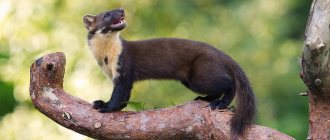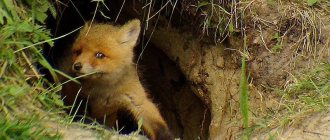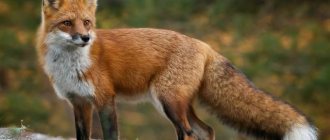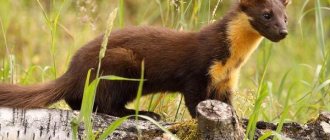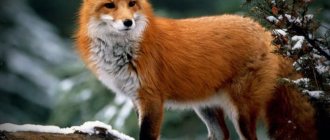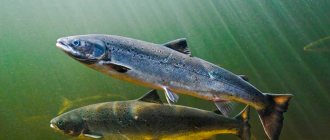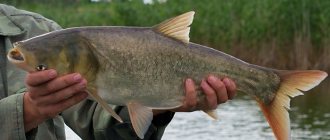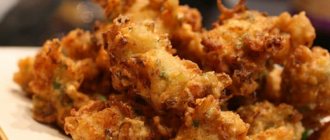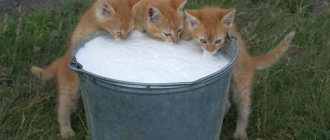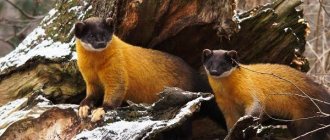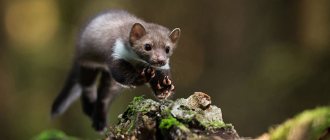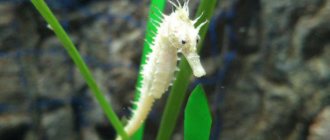The marten is a small predatory animal from the mustelidae family. The first ancient relative of the marten appeared about 35 million years ago. Currently, the genus of martens is represented by eight modern species and one extinct one.
Martens have an excellent sense of balance, the ability to quickly climb trees and make jumps up to 3-4 meters long. Their feet can turn 180 degrees, and their sharp claws and fangs cause dangerous lacerations. Such characteristics of the animal allow it to be an excellent hunter and successfully attack prey whose size exceeds its own.
In general, representatives of the marten genus are not endangered, but in some regions, due to intensive hunting and shrinking natural habitats, the populations of these animals are catastrophically declining. This became the reason for the inclusion of subspecies of the predator in the regional Red Books.
Characteristics and description
Most species of martens are active at night. Only the harza leads a diurnal lifestyle. Each adult has its own area, with the males' areas occupying a larger area. In winter, when there is much less prey, martens are forced to expand their territory for daily crawling.
After a hunt, a predatory animal usually rests in hollows or crevices of trees, squirrel holes or bird nests located high above the ground. Martens live in one territory throughout their lives, but do not have one permanent shelter. They choose several suitable places in which they periodically stay for daytime rest.
Animals do not hibernate. Before the onset of cold weather, they stock up in hollows and wait out the bad weather without leaving their shelter.
By the nature of their behavior, martens are loners. They can unite in pairs only for a short time during the rutting period. The exception is the harza, which can form groups of several individuals to hunt together, which allows it to cope with fairly large prey.
What does it look like
The appearance of martens has the following features:
- the body is elongated, flexible, the back is slightly curved;
- the head is small, with an elongated muzzle, the neck is long and very mobile;
- the ears are small, rounded, located on the sides;
- paws are thick, short, with five separate toes;
- the tail is long and fluffy.
The color of the predator depends on the variety. The predominant tones in the colors of martens are various variants of brown.
The sizes of some types are shown below.
| Variety name | Body length, cm | Weight, kg |
| Kharza | 70 | 5,8 |
| Ilka | 75 | 5 |
| Belodushka | 55 | 2,3 |
| Japanese sable | 54 | 1,6 |
| American marten | 45 | 1,3 |
Sable and marten: differences
Japanese sable
Animals are representatives of the same genus and have a certain external similarity. You can distinguish a sable from a marten by some characteristic features:
- sable has shorter mustaches;
- his ears are smaller, with pointed ends and moved back;
- The marten has a bushier tail;
- The sable's body is more compact and heavier.
The animals also differ in their habits: the sable lives on the ground and makes its nests between the roots of trees and in hollow trunks of dead wood, while the natural habitats of the marten are branches located in the upper tier, squirrel or bird nests.
The shiny and evenly colored sable fur is valued much more expensive than the fur of the coarse-haired marten.
Martens: description
It is believed that the marten is not a small animal, and its natural habitats are mixed or coniferous forests, with a large number of old trees with hollows, as well as impenetrable thickets of various vegetation. In such conditions, this predator easily obtains food for itself, and builds nests for itself in the hollows of old trees.
Interesting to know! A marten can climb a tall tree in an instant, easily jumping from branch to branch, while using its luxurious tail as a rudder and parachute. In addition, the marten is an excellent swimmer and runner, especially in deep snow. The edges on the paws do not allow the predator to sink deeply into the snow.
Such characteristics of the animal allow it to be an excellent hunter. The marten hunts small animals, amphibians and birds, while it is the main enemy of the squirrel, since it is able to easily and quickly move in the crowns of trees, as well as jump from branch to branch, which are located at a considerable distance from each other. She will not let a single bird's nest pass by without inquiring about the availability of food items. Many birds suffer from this, regardless of where their nests are located - on the ground or high in a tree. By hunting in its territory, the marten brings great benefits, since it also hunts rodents, not allowing their populations to go beyond the limits of reason.
Appearance
The marten has a lush and beautiful coat, and in winter the fur is thickest and most attractive. It should be noted that the base color can vary and take on different shades of brown. In this case, the area of the animal’s back is always darker than the rest of the body. In the chest area there is a bright yellow spot, which in winter is not as bright as in summer.
The marten has relatively short limbs with paws armed with very sharp claws. Each paw has 5 toes. The animal's muzzle is noticeably pointed, and its ears are short, triangular in shape, edged with yellow fur. The body of the predator is elongated, measuring up to half a meter, with a weight of no more than 2 kg, while the weight of males is slightly greater compared to the weight of females.
Behavior and lifestyle
The shape of the body, as well as low limbs, indicate that the predator moves using characteristic jumps, which affects the animal’s lifestyle. In addition, the flexible and slender body indicates that the animal feels great in the crown of various trees, quickly and lightningly jumping from branch to branch. The marten feels quite comfortable at heights, since its sharp claws allow it to stay on the smoothest surfaces.
Important point! It prefers to lead a diurnal lifestyle, moving in the treetops in search of food items. He is afraid of the person and always tries to avoid this meeting.
The marten's nest can be located at a height of at least 10 meters, and for this it can use the hollow of an old tree or simply the crown of a tree. This is a predator that is strongly attached to its territory and leaves it only as a last resort. This is especially true during periods of squirrel migration, when martens, following them, leave their inhabited territories.
There are so-called passage areas of forests, where martens appear very rarely, and so-called “hunting grounds”, where the predator spends almost all of its time. In the summer, the “hunting grounds” may narrow if there is sufficient food. In winter, on the contrary, the territory expands significantly due to a lack of food supply.
Marten interesting facts
Types of martens with photos and names
The marten is a predatory animal belonging to the mustelidae family. In nature, there are several varieties of these animals, the differences of which are very insignificant and mainly depend on their natural habitat.
American marten (Martes americana)
It is considered a rare, little-studied species, but in terms of external characteristics, the American marten can be compared to the forest marten. The main color of the animal varies from yellowish shades, while the chest area is lighter, and the limbs are darker, almost black. The way of life and behavior of this predator cannot be fully studied, since the predator is predominantly nocturnal and does not allow people to get close.
Ilka (Martes pennanti)
This species is represented by a large animal, with a body length of up to 1 meter (including tail), and a weight of about 4 kilograms. The coat is dark, made in brown shades. In summer, the coat is shorter and stiffer, and in winter it is longer and softer, with a noble silver tint. The ilka's diet consists of animals such as squirrels, hares, rodents, arboreal porcupines and various birds, while the predator eats fruits and berries with pleasure. Ilka's hunting is very diverse and does not depend on where the prey is located - high in the trees or on the ground.
Stone marten (Martes foina)
It mainly lives in Europe, settling close to human habitation, which is not considered typical for this family. The coat of this predator is quite hard and has a gray-brown tint. The chest area is distinguished by the presence of a lighter, almost white area of fur that extends to the beginning of the forelimbs. It is not so difficult to distinguish the stone marten from other species, since its nose and feet are lighter, without noticeable pubescence. This animal hunts small rodents, frogs, lizards, birds, as well as various insects. Can eat objects of plant origin, but only in summer. In addition, they hunt domestic animals and birds. Due to the presence of valuable fur, this type of marten quite often becomes an object for hunting.
Pine marten (Martes martes)
This species is mainly distributed on the territory of the Euro-Asian continent. The main color of the animal is brown, with a yellow spot in the throat area. The diet consists of both animal and plant foods, although the basis of the diet is meat, which the predator obtains by hunting squirrels, rodents, amphibians and various birds, and does not disdain carrion. In the summer, the animal introduces plant foods into its diet, in the form of berries, nuts and fruits.
Harza (Martes flavigula)
Due to the fact that the animal has an unusual coat color, many consider it a separate species. This is a relatively large species of the mustelid family, since its total length (including tail) reaches a meter, or even more, and the weight of individual individuals reaches 6 kilograms. The kharza hunts many species of animals that it can handle. On occasion, it may include amphibians and insects in its diet. In summer, her diet is more varied and includes components of plant origin.
Nilgiri harza (Martes gwatkinsii)
This species is somewhat smaller, although the length of adults can reach up to 1 meter, although their weight is only 2 and a half kilograms. The behavior and lifestyle of this predator have been poorly studied, since this animal spends almost all its time in tall trees and descends to the ground only to hunt. It is assumed that the Nilgiri harza leads a predominantly diurnal lifestyle. According to some evidence, this type of marten hunts squirrels and birds.
How long does a marten live?
Being in its natural habitat, under favorable conditions, the animal is able to live for about 15 years, although in fact this term is considered the maximum. The fact is that the marten has many food competitors that are stronger than the marten. Despite this, the marten does not have many serious natural enemies that could significantly affect the total number of these predators.
Basically, the total number of martens depends on the availability of food supply, which, in turn, depends on certain factors. For example, in the spring, as a result of floods, many rodents die, which occupy a significant place in the food supply of this animal. In addition, forests that represent the natural habitat of this predator are being cut down at a rapid pace.
Natural habitats
Martens and forest are concepts that cannot be separated, since this animal prefers to live in forest plantations. These can be spruce, pine or mixed forests, regardless of the habitat - northern or southern.
For its life activities, the family chooses areas with a large number of fallen trees, as well as tall trunk trees. In addition, the presence of clearings and young dense undergrowth is very important.
The marten is also found in flat areas, as well as in the mountains, in the presence of vegetation. It can also be found in the valleys of both large and small rivers. Some species prefer to live among rocks and rock deposits. As a rule, most members of this family avoid the presence of people. An exception to the rule is the stone marten, which can be found near human habitation.
Interesting moment! What is characteristic of the marten is that it is distributed over most of the Euro-Asian continent, unlike some other representatives of the mustelid family.
Marten habitat!!!
What does a marten eat?
It is believed that the marten is an omnivore, although the basis of its diet is animal food, represented by small animals, including field mice. In large numbers, martens exterminate rats, since not all cats are able to cope with this rodent.
Martens destroy bird nests and also prey on amphibians and reptiles. Often, especially when there is a lack of food supply, they eat carrion. In the summer, their diet is more varied, since it includes plant foods in the form of berries, the marten especially loves rowan, as well as nuts and fruits.
With the onset of autumn, the marten begins to form reserves for the winter, which allows it to survive such harsh conditions. The diet largely depends on living conditions, which is associated with the presence of appropriate food components. The marten feels great at altitude, but it feeds mainly on the ground, where the diet is more varied and richer, especially in the summer.
The stone marten can resist the bites of bees and wasps, so it has no problem raiding apiaries and also feeds on wild honey. She can easily visit any chicken coop or other outbuilding if there is something to eat in it. Often the marten kills more animals than it can carry with it, which causes a lot of harm
Natural enemies
The marten does not have many natural enemies that could successfully hunt such a fast animal. Despite this, the natural enemies of the marten are wolverines, wolves, foxes, leopards, as well as birds of prey such as eagles, golden eagles, eagle owls, etc.
Reproduction and offspring
As a rule, the total number of martens, from year to year, is almost at the same level, which is associated with the omnivorous nature of this animal. If there is not enough food, the marten easily switches to another type of food supply. If there is a shortage or excess of food for several years in a row, this can have both a positive and negative impact on the total number of these animals, although such factors are extremely rare. The marten population can be significantly influenced by humans if they actively fish for this animal. Upon reaching 3 years of age, martens become sexually mature individuals. At the end of summer their mating season begins. After mating, the female carries her future offspring for 8 months. This is due to the fact that the embryo begins to develop only with the onset of spring.
At the end of the pregnancy, the female gives birth to 2 to 8 babies, naked, blind and completely defenseless, and their weight is no more than 30 grams. After a month they begin to see, and after a while they have teeth, after which the female begins to teach them to eat animal food. Already at 3 months, babies can easily jump on tree branches, and at six months they begin to independently obtain food for themselves. After a couple of months, it is already possible to distinguish females from males, since they begin to lag behind in weight and size. This difference persists throughout life.
Before the real winter cold begins, the young offspring grow to the size of adults, after which the family breaks up. For young offspring, it is very important to find unoccupied areas, although at first the young hunt on the territory of their mother. At this stage, young animals are most vulnerable to their main natural enemies.
Species of representatives of the mustelidae family
Nilgiri Kharza
Let us consider in more detail the types of martens, their external signs and habits.
- Pine marten . It lives throughout Europe and in the European part of Russia. A distinctive feature of the animal is a bright yellow spot in the form of a triangle located under the neck. This predator is more adapted to life in trees than any other subspecies.
- Kharza . Also known as the yellow-breasted or Ussuri marten. The largest species, which is easily recognized by the bright yellow color of the front part of the body. Harza is widespread in southeast Asia, as well as on the islands of Java, Sumatra and Kalimantan. A separate population of the predator lives in the Primorsky and Khabarovsk Territories.
- Nilgiri kharza . A little studied species, small populations of which are found in the south of Hindustan. The animal has a dark brown body color with a bright yellow spot on the neck and chest.
- Stone marten ( Martes foina ). The animal is distributed in temperate latitudes of Europe and Asia. Due to the white forked spot located on the chest, the animal is also called the white-breasted marten or white-breasted marten. The predator is found mainly in forested foothills and can live at altitudes of up to 4000 m above sea level.
- Ilka . Also known as pecan or fisher marten. The animal lives in tall coniferous forests of North America. In winter, ilks do not climb trees, but dig holes directly in the snow. Contrary to their name, pecans practically do not feed on fish. Their favorite foods are arboreal porcupines, rodents, birds and young hares.
- Sable . Despite the ability to move deftly through trees, it prefers to hunt and seek shelter on the ground. Distributed in the taiga. A few limited ranges are found in northern, central and eastern Asia. Until 17 AD, sable was common in northern Europe, but due to the high value of its fur, the animal was completely exterminated there.
- American marten . Distributed in the temperate climate zone of North America. The animal is medium in size, color varies from light yellow on the chest and neck to reddish brown on the back and sides.
- Japanese sable . The historical habitat of the animal was the southern islands of Japan. Later, the species was introduced to the northern islands for further extraction of the animal's valuable fur. Japanese sable has lighter fur, the color of which can vary from light yellow to yellow-brown
What does it eat?
The marten is an omnivore. The main part of the diet consists of rodents, reptiles, insects, and small birds. The animal can also destroy bird nests located on tree branches and on the ground. If there is a body of water near the hunting grounds, snails, frogs, and fish fry are eaten.
During periods when there is very little animal food, the predator switches to a plant-based diet, eating nuts, wild berries, seeds, and the fruits of wild apple and pear trees.
The marten is the worst enemy of squirrels: it is capable of chasing a rodent that comes into view for a long time, overtaking it in a tree or in a hollow. Often, after a successful hunt, martens use squirrel nests as temporary resting places.
The predator can eat carrion, although it does so reluctantly and when absolutely necessary.
What is the difference between sable and marten
For an inexperienced buyer, distinguishing sable from marten fur is an impossible task. This is exactly what enterprising sellers of fur clothing take advantage of.
After painting, things look exactly the same, but if you look closely, you can find the difference.
- Price. Like American mink, marten and sable are considered the most prestigious. But there is a difference in price for fur coats, hats, and clothes made of sable - it is noticeably higher.
- Wearability. Sable fur coats, according to owners, last for 16-17 years thanks to the elastic and thin skin.
- The difference is in the density of the pile. Sable is thicker and the axial hairs are much softer, as can be seen in the photo.
- Color. The marten is predominantly brown in color, while the sable's fur is much richer and its undercoat is a noble smoky color. That is why the marten is tinted to hide the difference and pass it off as a sable.
- Another difference between the fur of marten and sable is the unique and luxurious shine of the latter.
Where does it live?
The marten's habitat covers the northern and central parts of North America, almost all of Europe and certain regions of Asia. The predator is also found on the islands of Kalimantan, Sumatra, and Java. Unlike other representatives of the mustelid family, the animal is not found in South America.
OPOSSUM
Where does he live?
Stone marten
The natural habitat of most species of martens is lowland and mountain forests with a large number of trees. You can meet the predator in pine or mixed forests. Animals prefer to settle in areas with a large number of tall trees and dead wood, small forest clearings, and dense undergrowth.
Some species live in mountainous areas covered with dense vegetation. Natural zones suitable for the life of a predator also include dry subtropical forests and forest-steppes.
How do martens reproduce in nature?
Sexual maturity in males and females occurs at 2 years. The animals' rut occurs in mid-late summer. A distinctive feature of marten reproduction is the delayed development of the embryo.
The total duration of pregnancy depends on the species. For example, American martens bear offspring for a little more than 7 months, and pecans for almost a year.
At one time, a female can bring from 1 to 8 cubs. Newborn babies have no fur, they cannot see or hear and are completely dependent on their mother. During the first weeks, the female practically does not leave the brood, finding prey as close to the nest as possible. At one month, the cubs' eyes open, then teeth erupt, and the female begins to accustom them to solid food. For the first time, grown-up babies leave the nest at 3 months, and at 6 months they already try to hunt on their own. First, young martens search for prey in their mother's territory, and then look for free areas. During this period they are quite vulnerable to predators.
MUSKRAT
How to choose a fur product
Sable and marten fur is used for sewing women's and men's outerwear, hats, collars, and decorative elements, especially in designer models.
When buying such things, you need to know what to look for and how to distinguish a fake:
- The first thing you need to pay attention to is the mezdra. The buyer has every right to ask the seller to slightly tear off the lining to see the back of the skin. It should be elastic, easily bendable, light in color and not rustle on the fabric.
- Check the elasticity of the hairs. In good fur, after pressure they quickly return to their original shape.
- Run your hand against the growth of the hairs - they should immediately fall into place without breaks or hesitations. If this does not happen, the fur may be damaged. Also, hairs should not fall out and remain on the palm.
- Inspect for rust. Sables and minks are often kept in cages, and the rods leave marks on the skins that cannot be washed off.
- Check the country of origin. Clothes made from sable are made exclusively in Russia.
- Lightness of even large products. Judging by the reviews, the weight of a mink or marten coat is practically unnoticeable.
- A durable product is distinguished by the number of seams - the fewer there are, the higher the wearability of the item.
Where to buy: review of stores and prices
The shops: Addresses: Website: Prices from (RUB): The shops: Addresses: Website: Prices from (RUB): MechGrad Moscow, Kolpachny lane, 9c1 Ekaterinburg, st. Kuibysheva, 44 St. Petersburg, Suvorovsky prospect no. 18 https://www.mehgrad.ru 240 000 Northern Fox Moscow, Institutsky lane, 12 https://severnylis.rf 200 000 My Fur Moscow, st. Dokukina, 12 https://moimeh.ru 230 000 FurMond Moscow, Baumanskaya street, building 7, building 1 https://furmonde.ru 165 000 KingSobol Moscow, Marshal Zhukov Avenue, 59 https://kingsobol.ru 160 000 Triumph Moscow, Prospekt Mira, 105, building 1 https://www.evro-mexa.ru 200 000 Camphor Moscow, st. Dokukina, 10, building 10 https://kamfur.ru 149 000 Fur Lux Market Gardener https://mexa-lux.ru 148 000 Kalyaev official site https://www.fursk.ru 149 000 World of Furs Moscow, Dokukina st., 10 https://www.mir-shub.ru 120 000 Emil Shabaev Moscow, st. 1812, no. 2 https://emilshabaev.ru 350 000 Elena Furs official site https://elenafurs.ru 261 000 Lapland Moscow, metro station Alekseevskaya https://l-norka.ru 170 000 Addresses
Sable and marten products are a valuable acquisition and a luxurious gift for yourself or loved ones. Such things are distinguished by an abundance of colors, beauty, durability and uniqueness.
Natural enemies
The main enemies of the marten in nature are larger predators: foxes, wolves, lynxes, wolverines. In most cases, the nimble and fast animal manages to escape from its pursuers. Birds of prey pose a much greater danger to him: hawks, golden eagles and eagle owls.
The kharza, the largest and strongest of all martens, suffers least from attacks from predators.
WOLF
Interesting facts about martens
- The marten never settles in a birch forest. This is due to the absence in birch groves of cones, nuts, acorns and other food for squirrels - the main prey of martens. In addition, the red fur of the animal is too noticeable against the background of white birch trunks.
- The ability of martens to deftly climb trees and jump from branch to branch is ensured by semi-retractable claws. These animals are the only representatives of the mustelid family with such a claw structure.
- Marten fur is one of the elite furs. It is thick, light, warm, and has a fairly hard down that prevents rapid wear of the products. The high price of marten fur is also due to the fact that it has to be obtained only during animal hunting. The marten does not tolerate life in captivity and despite all the efforts of breeders, they have not been able to develop a variety suitable for breeding on fur farms.
- Before the onset of cold weather, the animal’s feet are covered with fur, which greatly facilitates movement on snow and ice.
- Hybrids may appear where the ranges of different marten subspecies intersect. The most studied is kidas. This hybrid of sable and pine marten is larger than its parents. According to existing information, the offspring of kidas are sterile.
- In the south-east of Australia there lives a tiger cat, whose second name is the spotted-tailed marsupial marten. The animal received its name due to a certain external resemblance to European and Asian martens, but there is no relationship between the species. Another similar Australian species of marsupial predator is the speckled marsupial marten, or quoll.
Advantages of marten
Marten fur has many advantages - softness, beauty, lightness. But the main thing is practicality. Thanks to the hard and thick undercoat, the products are very durable. For 7-10 years, marten fur coats retain their appearance. Thanks to the ventilated structure of the pile, dust does not accumulate on the fur coat, which makes it safe for allergy sufferers.
Fur products
